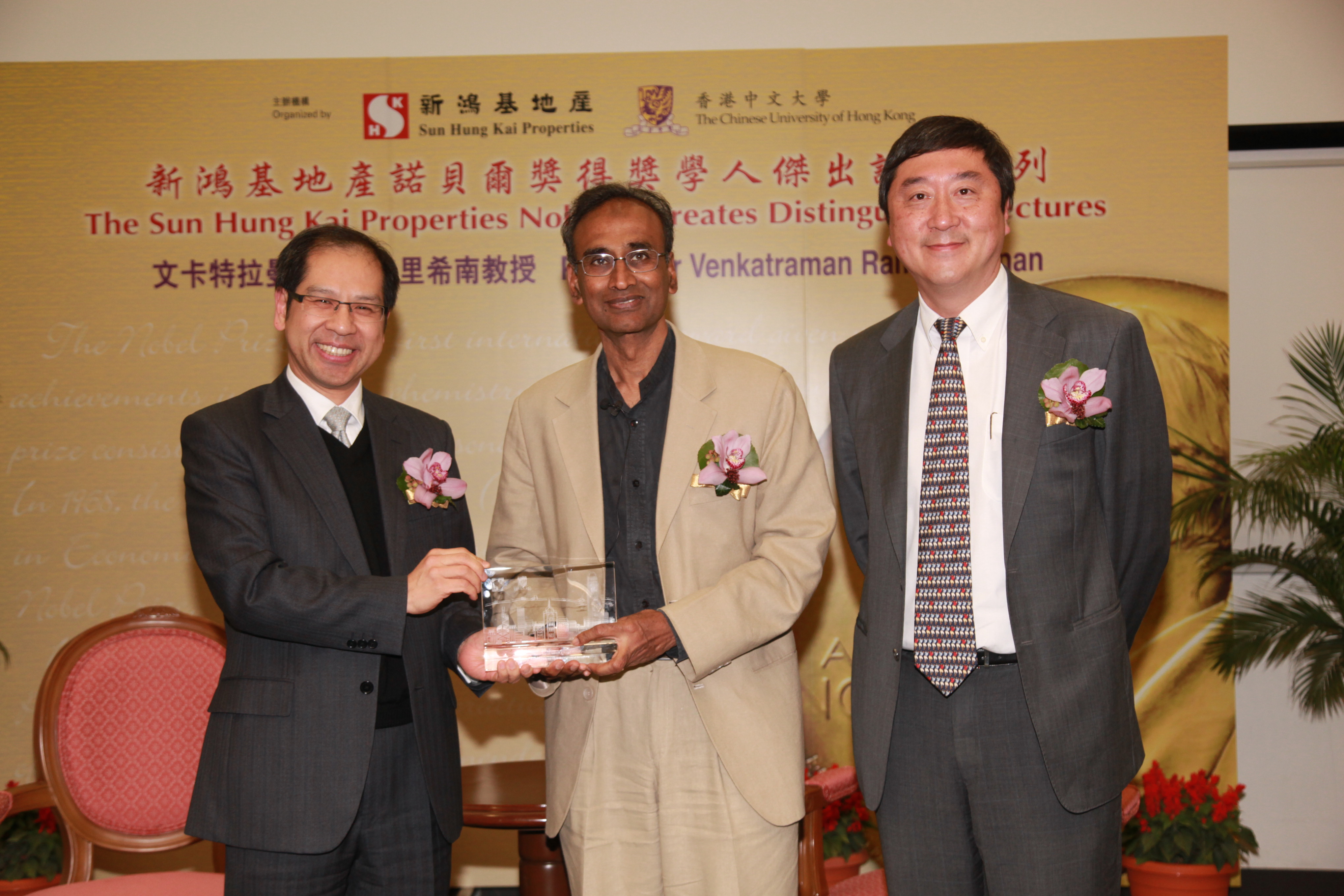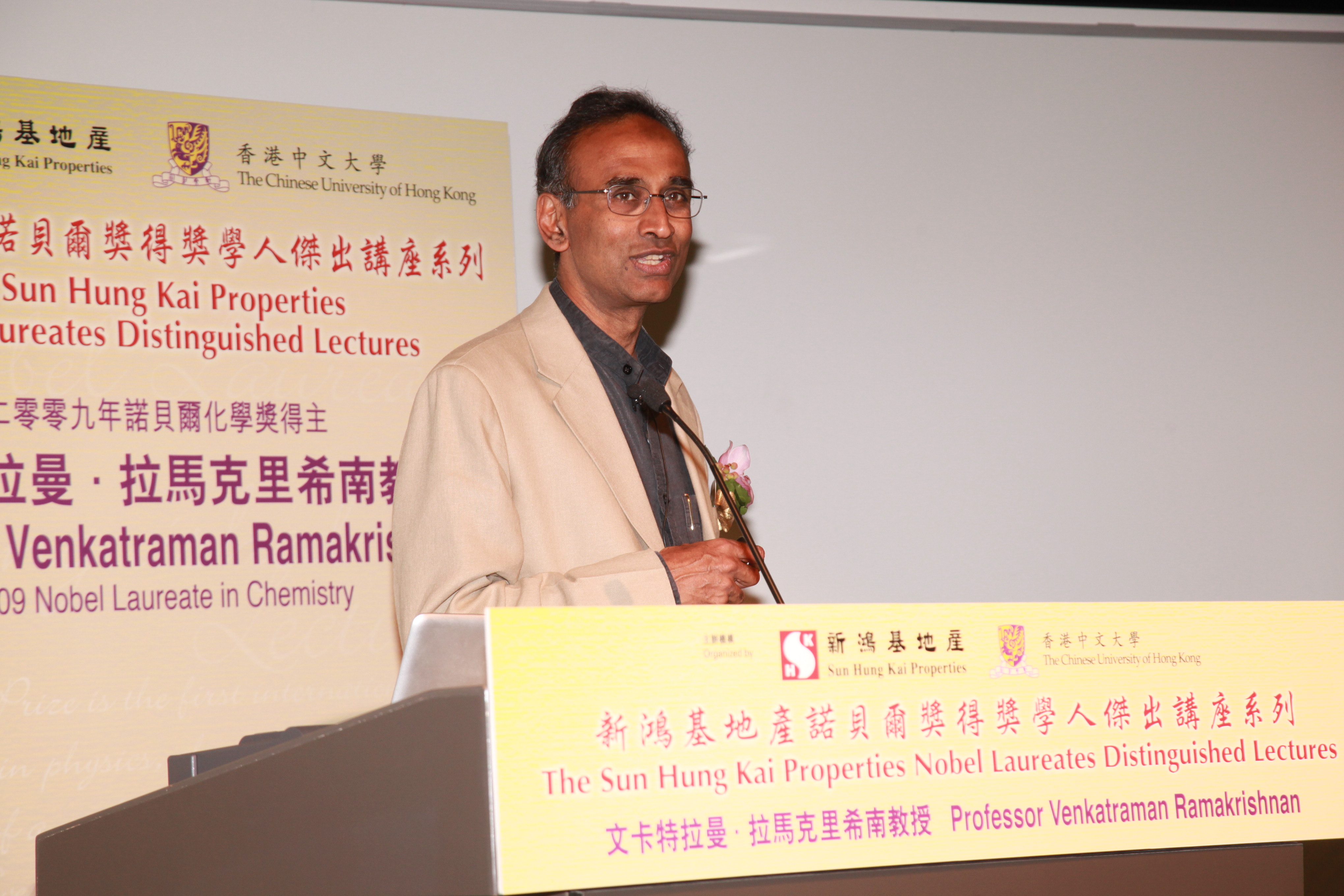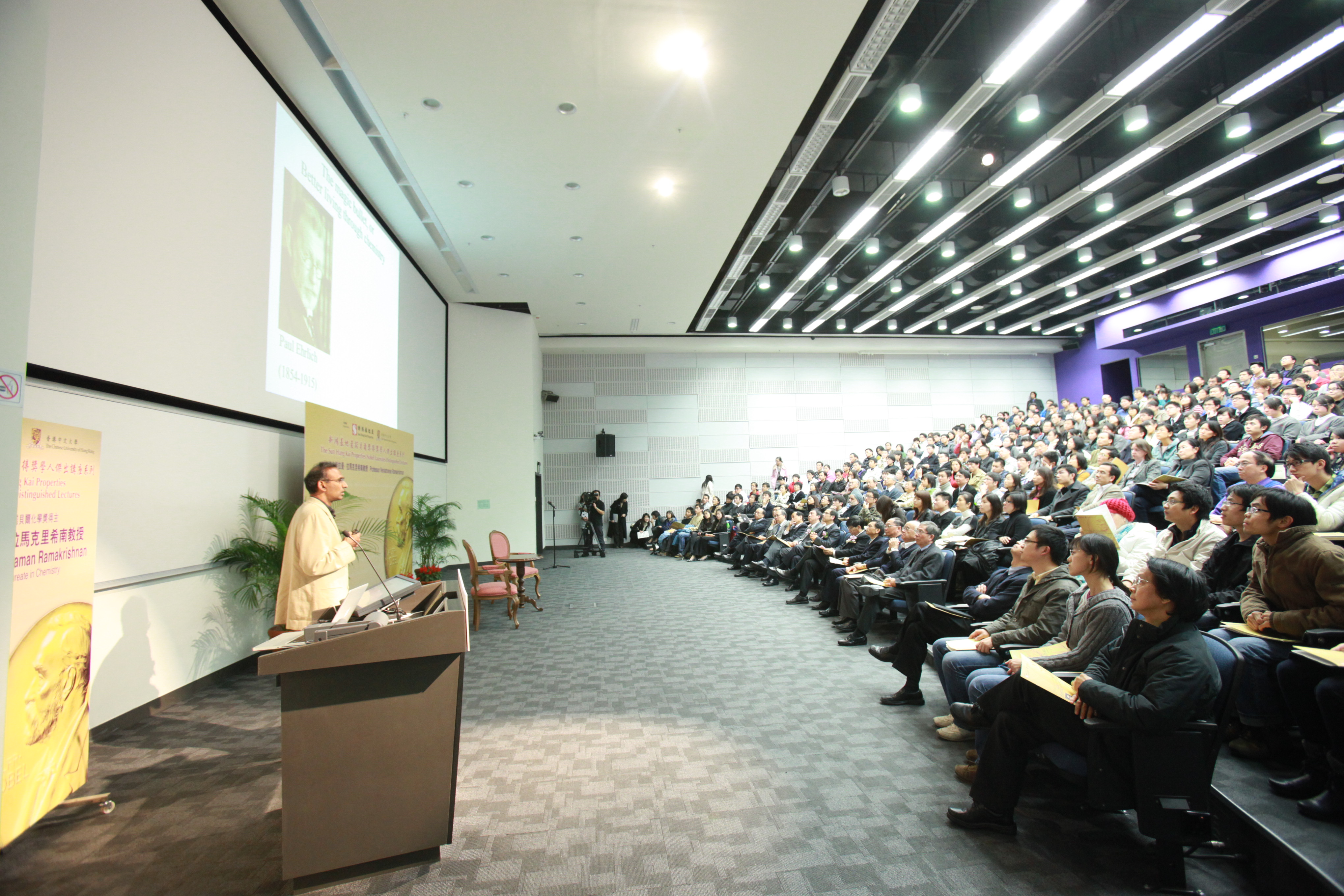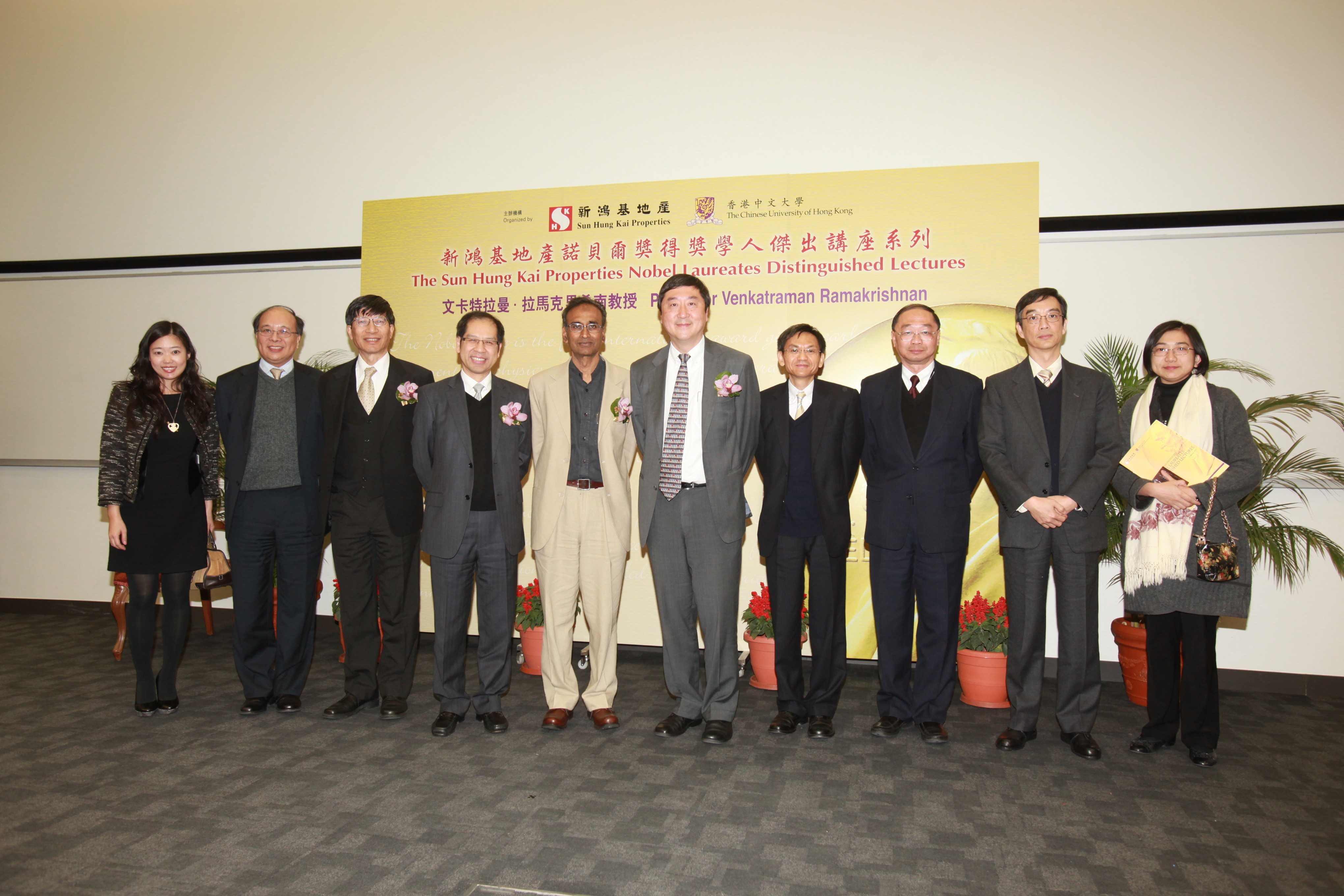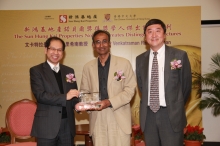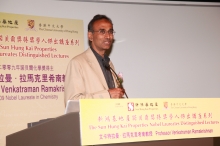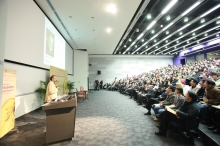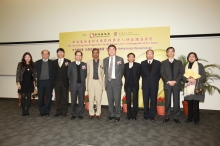CUHK
News Centre
SHKP and CUHK Present Nobel Chemist Lecturing on How do Antibiotics Fight Against Infectious Diseases
Sun Hung Kai Properties (SHKP) and The Chinese University of Hong Kong (CUHK) presented a public lecture today (6 January) on ‘How do Antibiotics Block the Protein Factory of Pathogenic Bacteria?’ by Prof. Venkatraman Ramakrishnan, 2009 Nobel Laureate in Chemistry. The lecture drew a full house of over 350 academics, students and members of the public.
During the lecture, Professor Ramakrishnan closely interacted with all students and attendants by sharing his valuable experience in scientific research over the years.
Mr. Patrick Chan, Executive Director and Chief Financial Officer of SHKP, said, ‘SHKP advocates “Building Homes with Heart” and is dedicated to promoting education and life-long learning in various ways as part of our commitment to good corporate citizenship. We are very pleased to have rolled out The Sun Hung Kai Properties Nobel Laureates Distinguished Lectures series with the Chinese University since 2004. The series has brought many world-class scholars and scientists to CUHK to share their erudition and innovative ideas. This broadened the vision of Hong Kong citizens and inspired in them the desire to pursue knowledge.’
CUHK Pro-Vice-Chancellor Prof. Kenneth Young thanked SHKP for its support over the past seven years. He added, ‘In 2000, Professor Ramakrishnan and his associates determined the atomic structure of part of a ribosome, the first time that the structural secret of the protein factory is elucidated, in a sense analogous to the work of Watson and Crick in determining the atomic structure of the DNA more than half a century ago. Professor Ramakrishnan then made very important further discoveries, determining how antibiotics can stop protein factory. His research on ribosomes won him the Nobel Prize in Chemistry in 2009. His work has great translational potential, as many scientists are now employing the models he created to develop new antibiotics, for combating pathogenic bacteria. This has become an urgent task, as we are now facing more and more bacterial infections that are difficult to treat and resistant to the antibiotics that doctors now have at their disposal.’
Infectious diseases caused by pathogenic bacteria have become a world-wide problem. Nearly half of antibiotics act by blocking protein synthesis in bacteria. In this talk, Professor Ramakrishnan gave a brief introduction to the idea behind antibiotics, and then talked about the ribosome, the large molecular machine that translates the information in our genes to make proteins in all forms of life. He concluded by showing how the atomic structures of the ribosome were used to see directly how antibiotics would block its function, and about how this information is now being used in the design of new antibiotics.
Prof. Venkatraman Ramakrishnan grew up in India and moved to the U.S.A. in 1971. After initially being trained as a physicist at Ohio University, he switched to biology in 1976 at the University of California, San Diego. His interest in ribosomes dates back to 1978 when he joined Professor Peter Moore’s laboratory as a postdoctoral fellow at Yale University. He began his independent career at Brookhaven National Laboratory in 1983. In 1995 he moved to the University of Utah to become a professor of biochemistry. In 1999, Professor Ramakrishnan moved to his current position as a scientist at the MRC Laboratory of Molecular Biology in Cambridge, England. He is a Fellow of the Royal Society and a Member of the U.S. National Academy of Sciences.
In the past, Professor Ramakrishnan has also been interested in chromatin structure and in x-ray crystallographic methods. He currently focuses entirely on ribosome structure and function. In 2000, his laboratory determined the atomic structure of the 30S ribosomal subunit and its complexes with antibiotics. This work has led to insights into how the ribosome ‘reads’ the genetic code, as well as into various aspects of antibiotic function. In the last few years, Professor Ramakrishan’s laboratory has published structures of the entire ribosome in complex with tRNAs as well as release and elongation factors.
The lecture was shown live at local universities and the Hong Kong Science & Technology Parks to reach a broader audience. A hyperlink to the webcast was also provided by Hong Kong Education City for online viewing by secondary school teachers and students. There was a live feed to the Peking, Fudan, Shanghai Jiao Tong, Tsinghua, Zhejiang, Nanjing and Sun Yat-sen Universities on the mainland.
The Sun Hung Kai Properties Nobel Laureates Distinguished Lectures were inaugurated in 2004 with The Chinese University of Hong Kong. The series brings Nobel Laureates to speak to a broad cross-section of the community, to promote the discovery and the dissemination of knowledge, encouraging life-long learning and innovation. After this 17th installment of the series, 24 Nobel Laureates or renowned scholars were lectured in Hong Kong.
Mr. Patrick Chan, Executive Director and Chief Financial Officer, SHKP (left) and Prof. Joseph Sung, Vice-Chancellor, CUHK (right) present a souvenir to Professor Ramakrishnan
From left: Ms. Amy Tsui, Director of Communications and Public Relations, CUHK; Prof. Chu Ka Hou, Acting Director, School of Life Sciences, CUHK; Prof. Kenneth Young, Pro-Vice-Chancellor, CUHK; Mr. Patrick Chan, Executive Director and Chief Financial Officer, SHKP; Prof. Venkatraman Ramakrishnan, 2009 Nobel Laureate in Chemistry; Prof. Joseph Sung, Vice-Chancellor, CUHK; Mr. Mak Nak Keung, Corporate Planning and Investments Manager, SHKP; Prof. Henry Wong, Pro-Vice-Chancellor, CUHK; Prof. Shaw Pang Chui, Professor, School of Life Sciences, CUHK; and Ms. Janet Chow, Director of Institutional Advancement, CUHK


